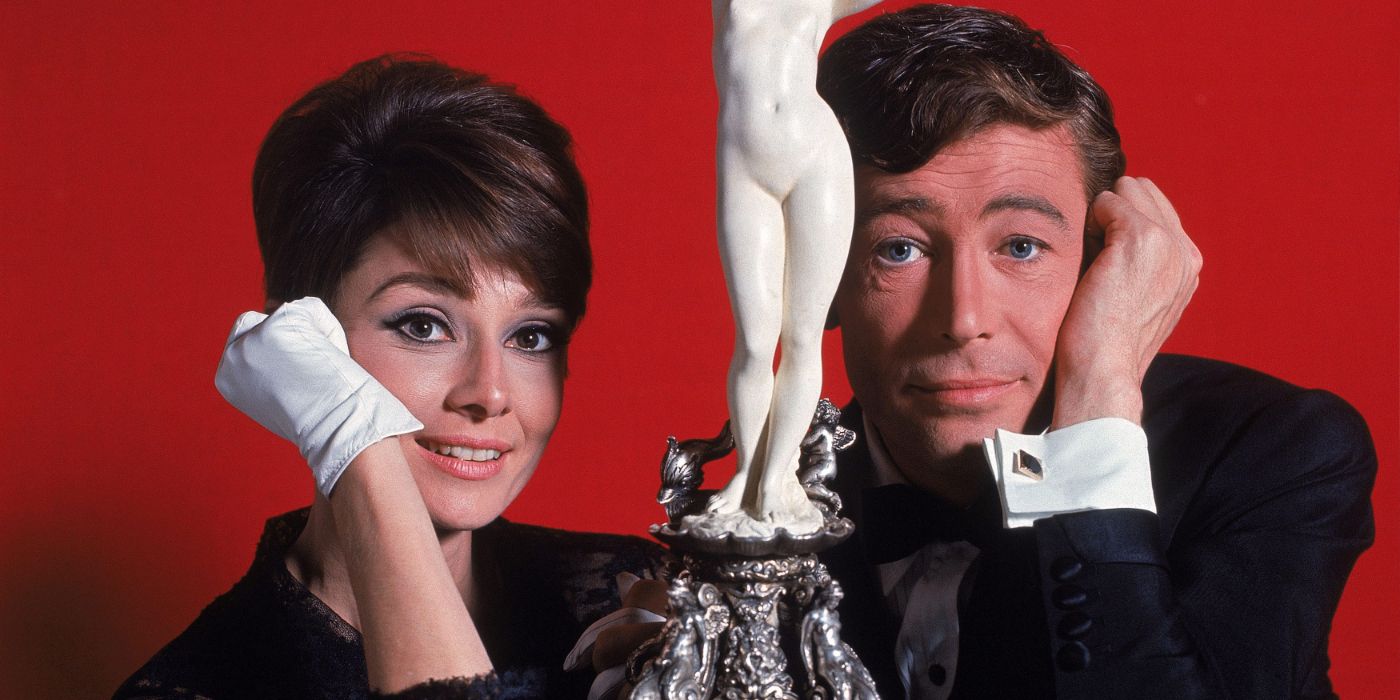The Big Picture
- Crime doesn’t pay, but charm does – as seen in
How to Steal a Million
, proving people love a thrill. - Audrey Hepburn and Peter O’Toole’s chemistry steals the show, blending mismatched personas in a captivating way.
- Director William Wyler balanced comedy with its stars’ onscreen presence in
How to Steal a Million
, making it a pure movie star film with an infectious vibe.
Crime still doesn’t pay, but sometimes it can look great and be oh so charming. If you have strong enough charisma and a compelling enough plan of action, you can pull a big audience in with the thrill of a fun time. A notable example is Richard Linklater’sHit Man which quickly became the #1 film on Netflix shortly after release; serving as an indication of people’s hunger for living on the wild side. For another example, look at a piece of 1960s hip entertainment with 100% on Rotten Tomatoes called How to Steal a Million, with Audrey Hepburn and Peter O’Toole as two connivers who team up to become art thieves with scintillating results.

How to Steal a Million
The daughter of an art forger teams up with a burglar to steal one of her father’s forgeries and protect his secret.
- Actors
- Audrey Hepburn, Peter O’Toole
- Release Date
- July 13, 1966
- Run Time
- 123 mins
- Director
- William Wyler
- Studio
- 20th Century Fox
What Is ‘How to Steal a Million’ About?
Nicole Bonnet (Hepburn) is the daughter of a very successful art forger named Charles Bonnet (Hugh Griffith), whose faux copies of iconic paintings have given them a lavish lifestyle in Paris. She constantly warns him that he’ll get in trouble for his career choice, but to no avail. When Charles decides to give a copy of a Venus statue to a museum, he unknowingly allows the museum to forensically examine it, which will surely prove it’s a phony and ruin his life. Nicole cannot allow that, and so she vows to steal the statue from the museum. In order to do so, she calls upon the help of Simon Dermott (O’Toole), a dashing art thief that she caught trying to steal one of her father’s fake Van Gogh paintings. It’s a natural oil paint meets watercolor paint match made in Heaven, as the two will engage in a classic bickering back-and-forth that’s so naturally delightful and effortlessly entertaining.
The dynamic between Nicole and Simon is one built around tolerating their irritation with each other for the sake of a shared goal. This is in line with many of the best relationships built on two people who won’t stop sniping at each other. Nicole finds Simon to be louche, ingratiating, and awfully insisting on his own charm. Simon finds Nicole to be a bad liar, moody, and a big goody-two-shoes. And yet what trounces all of those character mismatches is how obviously they’re into each other from the jump, with Hepburn and O’Toole wasting no time in acting like they’re not giving each other looks and not being all that bothered by being so close. It’s honestly very wholesome for two people brought together by the need to break the law.
While Nicole’s and Simon’s chemistry already makes enough sense on the page, what raises it into being the main reason to see the film is the casting of Audrey Hepburn and Peter O’Toole. Whether intentional or not, the film plays with a cute level of self-awareness about how the stars’ personas of the two match and mingle with each other. Hepburn was essentially the closest thing Hollywood had to a princess (Grace Kelly doesn’t count since she left Hollywood once she actually became royalty). Hepburn was a fashion and style icon who dazzled everyone with her humility and demeanor that created a tractor beam that many were powerless to. O’Toole, on the other hand, was an enigmatic troublemaker who could make all of his red flags disappear with his confident look and permanent smirk. As Simon himself perfectly describes the difference between her and him, “you are an aristocrat and I am a humble burglar.” This is almost objectively a mismatch of personalities, and yet pairing them creates magic in the way they create a tug-of-war between each other. Hepburn tries to pull O’Toole up to her level of sensibility, while O’Toole tries to yank her down to his level of delinquency, and we stay blessed for their mutual effort.

Related
Audrey Hepburn Dazzles in This Hitchcockian Thriller Hitchcock Didn’t Make
This 1963 thriller incorporates comedy, romance, and suspense all into one dazzling display of screen legend Audrey Hepburn’s movie star magnetism.
It must be said that there’s a wonderful irony in how Hepburn, in particular, allows herself to be portrayed. By this point in her career, she’d been evolving away from the pristine doll roles she’d gotten famous for and moved on to more daring roles that toyed with her image. Some of these notable examples include arguably two of her most iconic roles, in Breakfast At Tiffany’s and My Fair Lady, with audiences loving seeing her a little bit jaded and a little bit dirtier, respectively. With How to Steal a Million, the film has its cake and eats it too, letting Hepburn be both the refined lady everyone loved but also be a rule breaker on her terms.
She breaks into a museum to rob it, but only for the sake of helping her father. She’s decked to the nines in the chicest of mod-influenced outfits, but also has to dress like a dusty scullery maid for the heist plan to work. That setup leads to perhaps the funniest line of the film, where Simon cracks that “it gives Givenchy a night off,” referring to Hepburn’s real life fixation with being dressed by fashion designer Hubert de Givenchy throughout her career. The film is so giddy to admit how much fun it is to have the princess from Roman Holiday slumming it in the swinging ’60’s, and the vibes are infectious.
William Wyler’s Direction Emphasizes Comedy Over Thrills
For director William Wyler, whose handling of various shades of dramatic storytelling led him to be among the most Oscar-friendly filmmakers in history, this film was a marked shift for him. While he’d done a soft romantic comedy with Roman Holiday, he’d never done a film as broadly comedic as How to Steal a Million is, and he’s clearly putting far more stock in the film’s comedic potential than other elements. He goes as far as to goose little moments with goofy sound effects, like big drum bangings or slide whistles being paired with the clownish responses of the characters. A far cry from the high-wire daredevil tricks of other notable heist movies like the Mission: Impossible franchise, or even the cool precision of Jules Dassin‘s Rififi, it feels more in line with the original Ocean’s Eleven, starring Frank Sinatra and Dean Martin. That film prioritized chemistry with its cast and hanging out in lavish locations over the actual heist mechanics. Similarly, Wyler much prefers watching Hepburn and O’Toole deny their affection for each other than dig into the details of the heist. There aren’t even that many details to go over, as the heist itself winds up being quite easily built around convenient placement of keys and the guards not being great at their job.
That’s not to say that the film’s negligible interest in heist science is a huge flaw, more that it’s a conscious decision on Wyler’s behalf. It’s a pure movie star movie, where the audience will only care insofar as the leads are asked to hold scenes all on their own. Why bother with whether their plan would actually work when Hepburn and O’Toole are on fire anytime they’re within five feet of each other, and the film is so committed to its leisurely tourism. It seems like a fair trade-off, as there’s no shame in indulging in a good hang-out film every once in a while, and How to Steal a Million will leave you happy that you got two hours stolen from you.
How to Steal a Million is currently available to rent or buy on Prime Video in the U.S.





































































